You can refresh your home interior with painting any content on ceramics. Patterns, drawings, abstract compositions are applied to the surface of such products. There are several available design techniques. To apply the image, you can use a purchased template or a self-made stencil.
Types of ceramics
The material for subsequent production of tableware, facing panels, decorative items and interior decoration is obtained by firing a clay mixture at an ultra-high temperature. The physical and mechanical properties of the initial raw material influence the type of the final product and the preferred technique of artistic design.
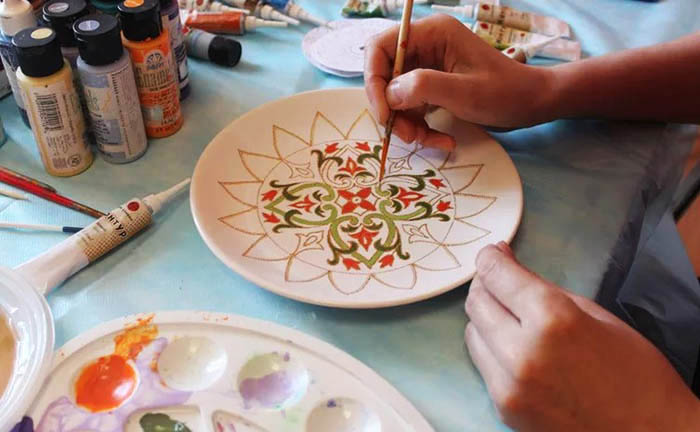
Painting on ceramics is a creative process and an exciting activity that can be done at home. Artistic design gives serially produced products an exclusive look.
The table shows the types of material used.
| Name | Properties and characteristics |
| Porcelain | Smooth material with a noble glossy surface. Porcelain is distinguished by its high fragility. When working with this type of ceramics, it is necessary to exercise maximum caution. Porcelain products are resistant to chemically aggressive effects. The type of ceramics is obtained by mixing white clay (kaolin) with feldspar and quartz in various proportions. |
| Terracotta | The characteristic reddish-brown color gave the name to the shade of the same name. The material is susceptible to synthetic and natural dyes. Terracotta has moisture-absorbing properties. Such ceramics are used mainly for the manufacture of decorative elements and items. The basis is ferrous clay. Such products have a matte porous texture. The original material is enriched with iron oxides, which give the characteristic color. |
| Majolica | The porous composition of the natural clay shade lends itself well to coloring. The surface is usually covered with a thin layer of glaze, which serves as a kind of canvas for further artistic design. Enamel dyes prevent the porous material from absorbing moisture. Majolica is made from red clay with the inclusion of polymer pigments and glass chips. |
| Faience | The noble material has a fine-pored structure, is highly hygroscopic and intolerant of extreme temperatures. Such products are coated with several layers of polymer glaze to increase mechanical strength and ensure the possibility of coloring. |
Less often, chamotte is used to make decorative items, dishes, and interior elements – a material made of fireclay, fired to a complete or partial loss of plasticity. Adding stabilizing substances and mineral powders to the raw material improves the performance characteristics of the grade.
Painting techniques
Overglaze, intraglaze and underglaze methods of decorating ceramic products are used. These techniques are similar in execution, but differ in principles and sequence of creative actions. The overglaze option is considered the easiest to implement. The technique involves creating an appropriate coating.
The glazed surface serves as a working space for creating a pattern, applique or unique design. The main advantage of this technique is the possibility of a wide choice of coloring compositions and shades. Intraglaze painting requires additional firing to sinter the coloring substance.
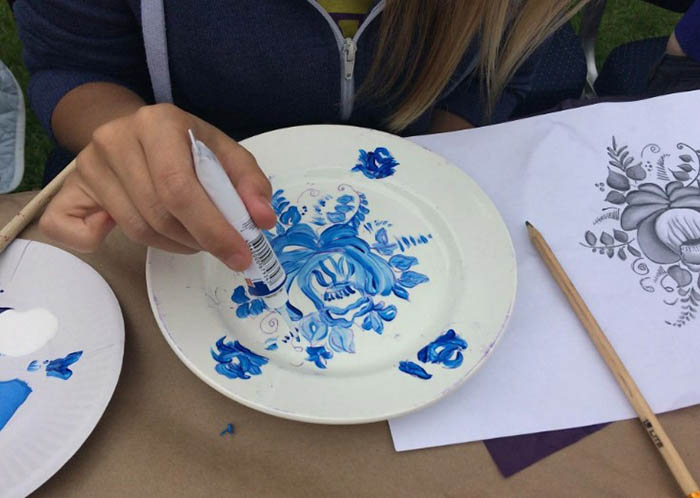
The technique allows to obtain a durable and stable drawing. The master must have experience in firing. Underglaze painting is considered the most difficult for practical implementation at home. The decorated product is covered on the outside with a colorless composition on a polymer base.
A durable film protects the paint from external influences, ensures the clarity of the contour drawing. After applying the artistic composition, the product is subjected to high-temperature processing. Below are the techniques for decorating items from such material.
Relief decoration
This type of decoration is called sculptural. Relief decor looks especially impressive on the surface of a floor vase, ceramic washbasin, large flower pot. You can decorate dishes and household items in a similar way. Special sculptural plastic is used.
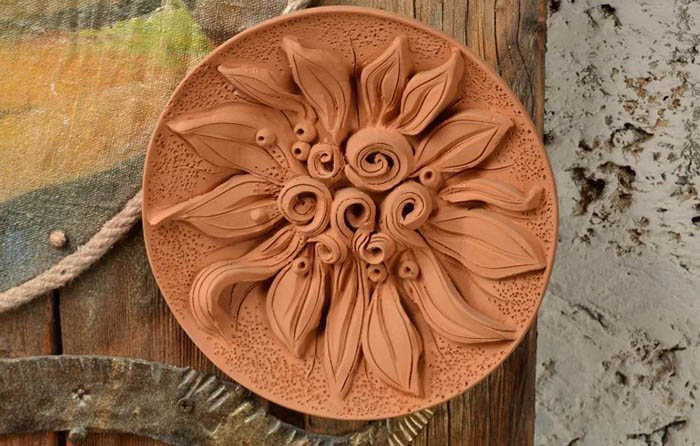
Painting on ceramics with the creation of relief ornaments involves, in its simplest form, the formation of wavy lines, zigzag grooves, teardrop-shaped notches and other artistic sketches.
Types of sculptural design:
- Ornaments. Such decoration can be wavy, lunular, comb-shaped. Sculptural plastic is applied to a moistened ceramic product, which after completion of the work is fired at a temperature of 180-220°C in an oven.
- Graffiti. The technique involves scratching geometric lines, letters and other elements and then filling them with acrylic paint. The disadvantage of this method is its short lifespan.
- Engraving. It is an analogue of the previous method with the difference that in the latter case the lines and grooves border the entire surface of the product or occupy a significant part of it.
- Embossing. It is best suited for decorating self-made clay products, as it involves decorating a still fresh item - before it is completely dry and fired. Embossing allows you to form intricate patterns and fantasy ornaments.
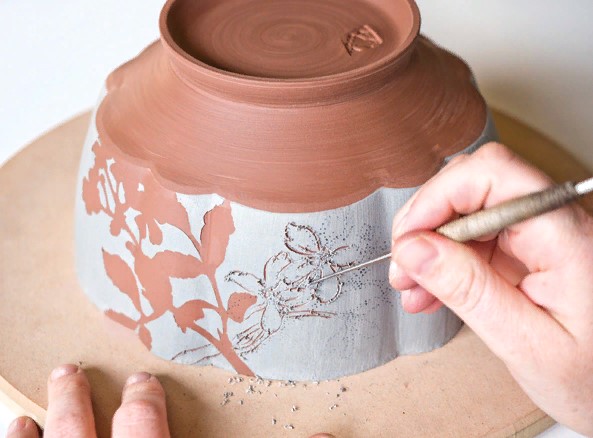
To create original color combinations, sculptural plastic is mixed with white clay or decorative powders, which add special optical effects to the decorated product.
Dot painting
This technique is called pique and involves forming an applique from individual dots. This type of painting creates the illusion that the surface of the product has been given a complex factory stamping.
For this work you will need the following tools and materials:
- acrylic paints in flexible tubes or plastic containers;
- contour markers or waterproof felt-tip pens;
- soft paint brushes, also suitable for artistic decoration of dishes;
- solvents for removing excess coloring composition – concentrated alcohol, acetone;
- a degreasing agent used to treat the ceramic surface before starting work;
- cotton pads or cosmetic sticks to ensure high precision of the design;
- polymer varnish in an aerosol can, allowing to fix the artistic composition and prevent the dye from coming into contact with destructive environmental factors;
- palette or its equivalent for mixing shades.
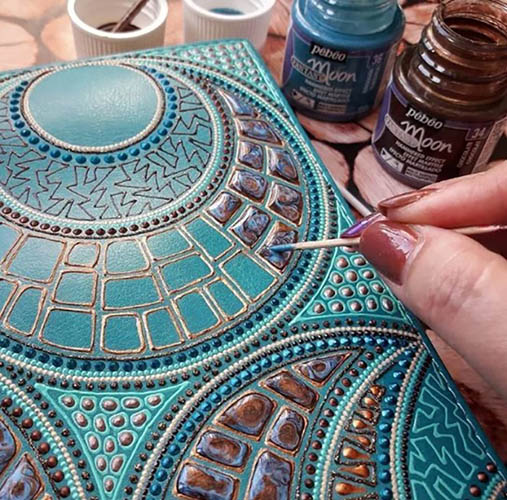
For the implementation of the dot technique, it is recommended to choose medium-density paint compositions. Thin lines are created with a sewing needle or a wooden toothpick. Manual drawing requires accuracy and precision of each movement.
The sequence of actions for creating a dot application on ceramic products:
- Degrease the work surface with an alcohol solution applied to a cotton pad. A cosmetic sponge or sponge is suitable for soaking the composition.
- Apply dots in the desired sequence. It is recommended to hold the brush or flexible tube with acrylic paint strictly vertically. This method ensures precision and accuracy of work. It is necessary to maintain equal intervals between drops of paint.
- Connect the dots with a brush of the desired thickness to obtain a contour line.
- Fill the body of the drawing with color. It is recommended to apply the paint in a thin, uniform layer.
Painting dishes or interior items using the dot technique involves removing excess drips and streaks with cotton pads. Hand painting on ceramics requires artistic talent.
Using a stencil or template
For such work, the best choice is an artist's brush made of elastic synthetic bristles. The method is intended for those who are not gifted with artistic talent.
You can use a purchased stencil or a printed image template. In the latter case, you will need a stationery knife or scissors for cutting.
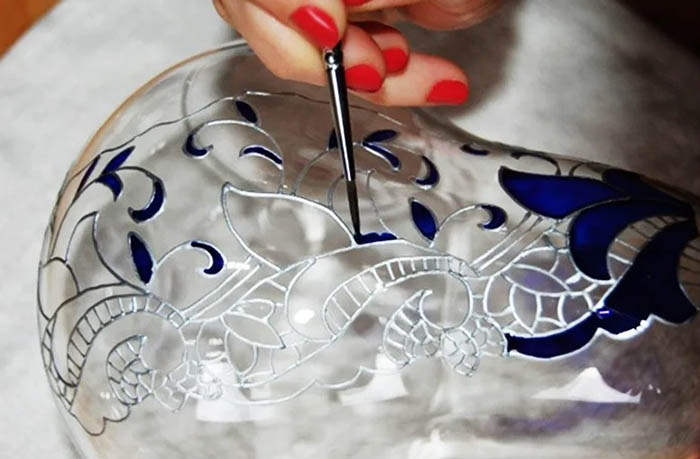
The next sequence of actions involves gluing the template or stencil to the work surface with tape. Preliminary degreasing of the decorated ceramic product is required.
The cut-out pattern is filled with acrylic paints using a sponge or cosmetic sponge. The final stage is drying the decorated product. It is not advisable to touch the surface with your hands during the work.
Artistic painting
The creative procedure is performed with a brush or a sharp pen. To create an artistic composition on a ceramic surface, polymer dyes, special compositions with a golden or other metallic sheen are used.
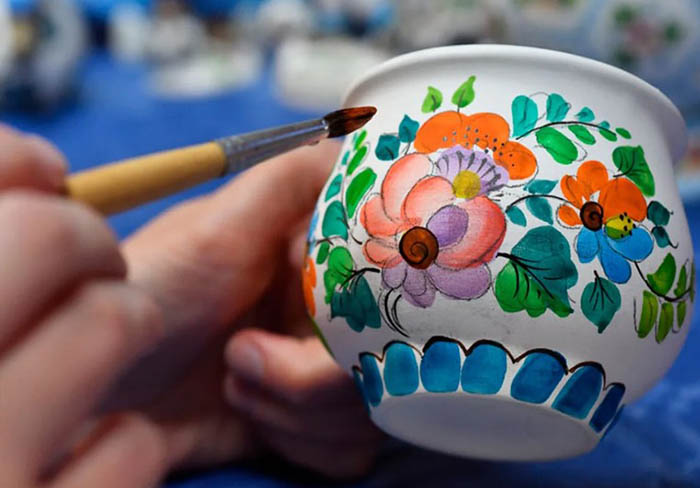
The drawing is framed with a thin contour border no more than 1 mm. In this way, ornate monograms, ethnographic ornaments, animalistic or floral images are formed.
Etching
The technique of creating a decorative pattern involves the action of acidic compounds on the ceramic surface. The etched pattern is filled with colored asphalt varnish or gold paint to imitate the elitism of the product.
Algorithm for performing artistic decoration:
- Glue the finished template to the surface to be decorated.
- Fill the slots with asphalt varnish.
- Immerse the product in hydrofluoric acid to etch the areas of the glaze free of coloring.
- Subject the decorated item to high temperatures in the oven.
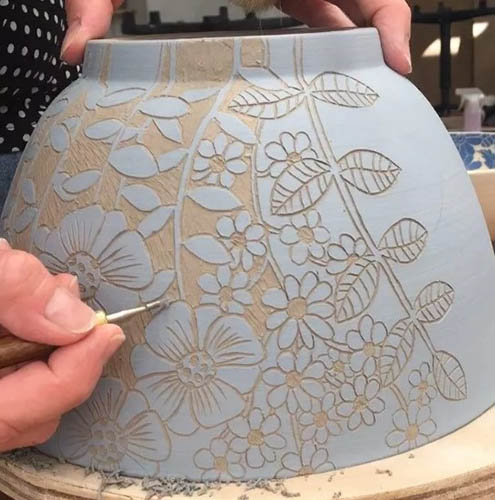
As a result of firing, the asphalt varnish acquires a smooth, shiny texture, and the free areas of the surface become matte. The technique is designed to create an expressive contrast.
They use imitation etching using a special polymer mastic for ceramic products. When fired, the composition burns out, the asphalt paint is fixed with a rough layer.
Seal
This technique involves the use of one shade, which is applied to the decorated surface using stamping. The method can be combined with additional hand painting with acrylic paints.
Printing on ceramics can be direct or transfer. The first option is used to decorate items with simple geometric shapes, without complex bends. The work requires a pre-made template made of thick foil, attached to the surface.
Painting on ceramics using direct printing involves applying paint with a brush or spraying it from an aerosol can. To obtain a complex application, several stencils are used in succession.
Abstract or fantasy designs are often applied in this way. An image created using direct printing is distinguished by clearly defined contours and the absence of small details.
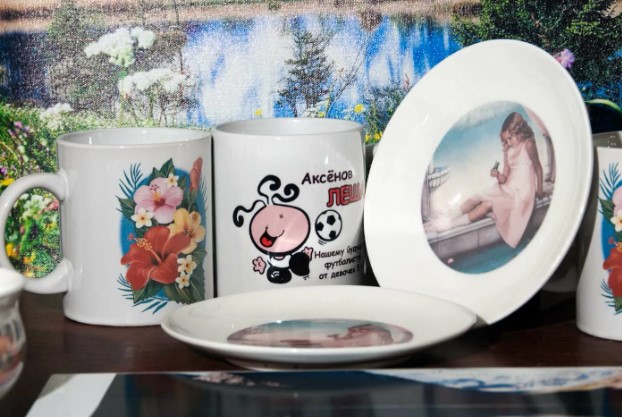
The transfer option requires creating a sketch on paper and then transferring it onto a ceramic surface.
Varieties of this method of decorating products:
- Pad printing. It involves the use of a silicone cliche, which is sold in special stores selling handicrafts. Such a device easily imprints a pattern when in contact with a ceramic surface. It is suitable for decorating items with complex geometry.
- Decalcomania. The image is transferred to the ceramic surface using the principle of a transfer picture. The drawing is created with heat-resistant paints, covered with varnish, and fired. The dye is baked into the surface, forming a colorful and durable image.
- Sublimation. The technique involves the use of a polymer film with a pattern applied to it. The image is formed using special sublimation ink or ink. When heated, the dye penetrates into the layers of glaze that cover the ceramic.
- Silkscreen printing. A purchased or self-made mesh stencil made of silk fabric is used as a stencil. The technique allows for the formation of elegant relief images in accordance with the thickness of the threads. Special thermoplastic paints are intended for silk-screen printing.
For exclusive decoration of ceramic products using the transfer printing method, numerous templates are sold with imitation of marble, wood, animals and other textures.
Style solutions
Stained glass decor is used, which gives a highly artistic twist not only to glassware, but also to porcelain. You can paint a mug, bowl or plate in the Khokhloma style. Initially, the technique was intended for decorating wooden items.
Khokhloma painting looks original on ceramic items or home interior elements. A bright pattern of such stylistic content allows to form colorful appliques in contrasting red and black tones.
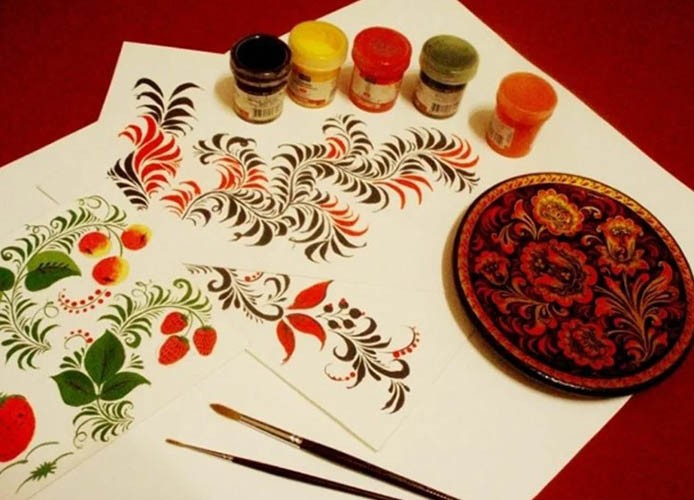
At home, Gorodets painting is used. This artistic solution is performed by combining beige and golden shades with delicate pastel colors.
The so-called merchant historical style fits harmoniously into the design of a modern kitchen. Gorodets painting often contains pastoral scenes, floral sketches, and images of domestic animals.
A suitable stencil can be purchased ready-made or printed out on a printer and applied to the ceramic surface with acrylic paints. Gzhel is specially designed for porcelain dishes.
Painting on ceramics of this type involves the formation of blue or sky-blue patterns. Tea and coffee sets are usually decorated in this spirit. The authentic Mezen style is popular.
This design is best suited for decorating single-color snow-white ceramic products. Mezen style contains geometric patterns and figures mainly in red and black tones.
Drying methods
After applying the dye, the item is kept for 24 hours at room temperature in a well-ventilated room. If firing in an oven is used, there is no need to dry the decorated item.
It should only be cooled naturally. Sharp temperature changes can cause the porcelain material to crack. A quick way to dry acrylic at home involves using a hair dryer.
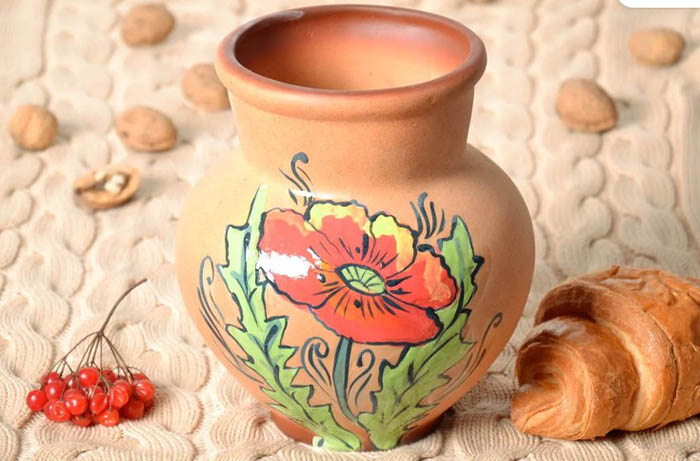
To bake the dye, the decorated item is kept in the oven for 30-40 minutes. The minimum temperature is 150°C. After the baking process is complete, the oven is turned off and the item is left inside until it cools completely.
This method of drying is used for artistic decoration of dishes from which food is planned to be eaten. For this purpose, the product can be used no earlier than 20 days after the dye has been applied.
Tips and tricks
The decorated object, regardless of the technique and method of applying the drawing, must be covered with a protective varnish composition on a polymer base. Such a product ensures the durability of the image.
Varnishing prevents fading and abrasion. When using a contour marker, it is recommended to immediately put on a protective cap after finishing the manipulation.
Such artistic accessory dries quickly, which negatively affects the clarity of graphic drawing. The decorated object for firing is placed in a cold oven for gradual heating of the layers of ceramic material.
Otherwise, there is a high risk of destruction of the product due to thermal shock. It is better to paint light or light green porcelain with translucent acrylic paints.
To increase the density, the composition is mixed with varnish or polymer mastic intended for application to ceramic surfaces. Increasing the consistency of the dye allows you to avoid leakage beyond the intended image boundaries.
The use of a mixture of acrylic composition with polymer mastic increases resistance to the effects of detergents, high temperatures, microwave radiation. After 20 days from the design, such dishes can be used without restrictions.
Acrylic painting covered with varnish can be easily removed with a cotton swab soaked in concentrated alcohol or acetone. After that, the object becomes available for painting on ceramics again. For manual creativity, it is advisable to purchase brushes of different calibers with squirrel bristles.
Video about painting on ceramics
